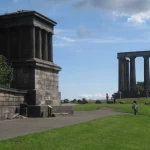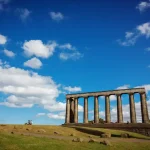Edinburgh World Heritage Site, Buildings, News, Development, Architecture
UNESCO World Heritage Site Edinburgh
Edinburgh World Heritage – EWH, Scotland, UK
Edinburgh World Heritage Site
This page is about Edinburgh World Heritage Status, the UNESCO mission, EWH, Development, Conservation and so on. It is written by Adrian Welch, and is completely independent of any organisation.
News Update – 22 May 2009
The masters degree unit at Scott Sutherland School in Aberdeen have now prepared a manifesto for Edinburgh: Towards a New Edinburgh. It is the culmination of nine months of study looking at the city and in particular the UNESCO world heritage site.
World Heritage Curse or Blessing
http://www.bbc.co.uk/iplayer/episode/b00kgzmw/World_Heritage_Curse_or_Blessing/
Edinburgh World Heritage Site Status – News Update, 2 Dec 2008
The Department for Culture has just announced a consultation exercise into the UK’s approach to UNESCO world heritage covering inter alia
“The consultation will also examine the costs and benefits, rights and responsibilities of World Heritage Site status, the balance currently achieved between them, and the implications for the future management, promotion and funding of such sites. The consultation will consider what measures might be taken to clarify and/or strengthen protection for World Heritage Sites and recommend a policy on making future nominations for World Heritage Site status”. It is introduced in http://www.culture.gov.uk/reference_library/consultations/5629.aspx
Of particular interest to Edinburgh might be a Price Waterhouse study carried out as input to the exercise. This examines the costs and benefits of inscription. The section for Edinburgh starts on page 38 of this report http://www.culture.gov.uk/images/publications/PwC_casestudies.pdf
These two comments might be of interest:
a. “There is no direct information on the role that World Heritage Status plays in visitors motivations to come to the city, the Edinburgh Visitor Survey has been undertaken annually since 1991 covering a sample of over well over 2,000 visitors per annum but does not ask explicit questions about what factors were important in visitors decisions to come to the city. It does however ask what impressed visitors most about the city and since 1991, it is understood that no respondent has ever mentioned the city’s World Heritage Status”.
b. “However it was also widely acknowledged that the WHS status increased the level of scrutiny on new development and the existence of Edinburgh World Heritage as well as the ongoing significant role played by Historic Scotland and the City of Edinburgh Council guarantees that continuous effort is made to ensure that the site and its heritage assets and qualities are provided with an effective voice.
Edinburgh was also the first city in the UK to employ a Design Champion in Sir Terry Farrell. This is to promote the idea that the quality of new buildings and structures should reflect the quality inherent in the WHS….. As we have also noted previously, whilst no consultees were able to state with confidence an example where WHS status had led to a development being halted, it is regularly mentioned in planning reports. Furthermore, there are examples where WHS status has influenced the revision of design proposals, such as ongoing negotiations concerning the Caltongate development”
UNESCO / Caltongate – Opinion Piece, 4 Sep 2008
Reading various articles in the Scottish Press over the last few weeks it is clear that the whole polarisation apparent at the time of the RIAS’s Hub Debate (Conservation v Evolution) has reared its ugly head again – very sad.
Rather than discussing how we work together to progress the mud is flying again. Much of the dialogue is highly inflammatory. Take Joanna Blythman’s article for the Sunday Herald. She describes CEC councillors as “Puffed up and romanced by developers and modernist architects who feed them the pretentious, self-aggrandising vocabulary of “iconic buildings”, “signature architecture”, “architectural statements” and “iconoclastic, brave development””.
Not content with that she takes a swing at Bennetts Associates’ Potterrow for the “capital’s number one vandal” University of Edinburgh. She slams the Quartermile development as a “riot of U-PVC and tinted glass”. She attacks Caltongate. And she attacks The Haymarket as the “most monstrously inappropriate scheme”.
You know there’s ‘trouble at’ mill’ when she bravely admits “I happen to agree, on the whole, with Leon Krier”. Oh dear, any vestiges of credibility gone. And her dining reviews are such fun!
Most telling is this observation: “The plans for Edinburgh become ever more scarring and radical.” As if radical is negative. Only in regressive Edinburgh. Take almost any other city or culture across the world and they would see ‘radical’ as a positive, but oh no, not in ‘oh-so-careful’ Presbyterian Edinburgh, we can’t have anything radical. That might suggest we could actually move forward, be progressive, join the rest of the thinking world and be creative and innovative; no we just want to sit back and admire what our ancestors did. Pathetic!
But on a more practical note what really matters is the quality of new buildings, scale, materials, design. This requires careful, considered judgement. Titles like WHS seem to matter to so many people, but why? Are people so easily taken in by such an empty badge? Why distract yourself with this when the reality is probably a subjective dislike for contemporary architecture? Admittedly some designs are poor, some mediocre and some good, that is the way of things.
The Houses of Parliament were disliked in their time as being too radical, and so is the Scottish Parliament. The point is to see the bigger picture, understand how other European capitals manage to proceed with vigour and creativity and focus on constructive dialogue.
Clearly Caltongate has unlocked great anger, and Meadowbank too (crazy idea to reduce sporting facilities – how does that reduce street crime and obesity?!) throw in other larger projects such as The Haymarket and Quartermile and you have the definite feeling of ‘too much too soon’. Democratic processes have to be followed, and people have to both feel and be involved. I competed at Meadowbank since I was a kid and join Chris Hoy in saying the proposed redevelopment is simply not right: sport and community are key factors to a city.
But we also musn’t get hung up on the WHS talisman, with 27 and counting in the UK I think its time we focus on ‘our city for us’, and not worry what UNESCO think.
Adrian Welch
BD article – ‘interview’ with Richard Murphy
http://www.bdonline.co.uk/story.asp?sectioncode=453&storycode=3121584
BD article – recent UNESCO visit
http://www.bdonline.co.uk/story.asp?sectioncode=426&storycode=3121300&c=1
Sunday Herald article – Joanna Blythman on built heritage
http://www.sundayherald.com/
oped/opinion/display.var.2436904.0.nothing_less_than_vandalism.php
Scotsman – Sir Terry Farrell (excerpts from BBC radio) appeals for calm
http://thescotsman.scotsman.com/scotland/City-39nothing-to-fear-from.4451465.jp
Scotsman – Open letter to Richard Murphy
http://thescotsman.scotsman.com/opinion/An-open-letter-to-Richard.4447018.jp
The importance of central Edinburgh has been recognised by UNESCO, with its designation as a World Heritage Site. The UK has (at time of writing, 2008) 27 UNESCO sites including Greenwich, Canterbury, Saltaire, New Lanark, Liverpool, Blenheim Palace, Ironbridge Gorge and Georgian Bath.
The centre of Edinburgh was designated a World Heritage Site by UNESCO in 1995.
If you are interested in starting a career in architecture, check out the various Online Accredited Degrees we offer in Architectural Drafting, Interior Design, and other related fields today!
UNESCO / Caltongate – Opinion Piece, 22 Aug 2008
“Regarding UNESCO’s intervention in Edinburgh’s democratic planning process. ( UNESCO / Caltongate – News Update Jul 2008 ). Mr Matsuura is a 71 year old career diplomat appointed in whatever arcane ways such people are chosen for such posts within UNESCO – as far as I can see he personally has no credibility in architectural/planning matters. As your references to other recent “causes celebres” indicate UNESCO generally is getting far too “active” on such matters in the light of the success and high profile of the World Heritage concept.
And its approach appears to be so anti “new development” that many of today’s iconic buildings from the 19th and 20th centuries in living “continuity cities” would never have been built if UNESCO had been imposing its policies then! I begin to wonder if inscription is really required by locations such as Edinburgh – does their Tourism strategy really gain much from it? Despite its own undoubted qualities Amsterdam has, so far, not gone for inscription because of the downsides and I suspect that Dresden is wishing it hadn’t bothered.
Gaining Inscription is a very costly process – the Lake District is putting aside £400,000 over 3 years just to develop its proposal! And, once achieved, Inscription makes a site a real “hostage” to pressure groups of all kinds since the threat of ignominious “delisting” is very powerful (and only the Sultan of Oman has so far been prepared to face it – but then he can afford not to care!).
I really do look forward to the day when a site will tell UNESCO that it doesn’t value its undemocratic interventions and withdraws from the scheme! Except that I can see no provision within the rules for a site to do so. Paul Tanner.
UNESCO / Caltongate – News Update Jul 2008
Like the IOC (Olympics) and the European Commission, UNESCO is an undemocratic body that wields immense power. This week their targets have included Edinburgh. Apparently The Scottish Government’s decision not to call the Caltongate plans in post-planning approval is understood to have led to Unesco’s decision to review the city’s world heritage status. They will send a mission to Edinburgh, in particular to the Caltongate development.
Status was conferred in 1995 and recently it has been used as a stick to try and prevent developments. Recently cities such as Cologne, London and St Petersburg have come under UNESCO’s scrutiny following approval of major developments, principally skyscrapers. Clearly world heritage status is coveted and beneficial to tourism, but essentially has little real meaning or intellectual value.
UNESCO – Edinburgh World Heritage:
Edinburgh World Heritage (EWH, formerly EWHT) was created by the amalgamation of the Old Town Renewal Trust and the New Town Conservation Committee in 1999. The Trust is funded by Historic Scotland and the City of Edinburgh Council.
The aim of The Edinburgh World Heritage Trust is to preserve or enhance the character or appearance of the Edinburgh UNESCO Site’s special architectural or historic interest. EWHT seeks to co-ordinate activities necessary for the protection of the heritage value of the Edinburgh World Heritage Site through controlled development.
Edinburgh World Heritage, 5 Charlotte Square, Edinburgh
Contact the EWH on 0131 220 7720
Edinburgh Skyline Study hosted at EWHT in 2007
More info on Edinburgh World Heritage Site:- www.heritage.edinburgh.gov.uk
Other UNESCO World Heritage Sites include the Taj Mahal, Florence and Prague.
Update Jul 2005
World Heritage Site Expansion?
EWHT Report proposes review boundary of Edinburgh World Heritage Site to provide better protection for historic buildings.
26.07.05
Edinburgh Council appointed the landscape architects Colvin & Moggridge from England to draw up a strategy to help planning officers assess proposals for tall structures.
Their study will provide a framework to look at how skyscrapers can fit in without damaging Edinburgh’s famous skyline, and constitute the first proper review since the Holford Tall Buildings Review in 1968.
In 1947 architects Holden & Holford carried out a review of London’s tall buildings.
World Heritage Site – Background
The concept of World Heritage Sites is based on UNESCO’s 1972 Convention for the World Cultural and Natural Heritage. The Convention noted that cultural and natural heritage was increasingly threatened by traditional causes of decay and changing economic and social conditions. UNESCO established the World Heritage Committee to compile a list of properties and sites considered to be of outstanding universal value.
The guidelines on World Heritage Sites recommend that historic urban centres should only be included on the World Heritage List if they are of exceptional interest. Edinburgh Old & New Towns are a blend of two urban phenomena – organic medieval and neo-classical town planning.
World Heritage status marks the need to manage and safeguard the special character of the Edinburgh World Heritage Site. To do so the World Heritage Partnership Group signed a Statement of Intent to work together to conserve and enhance the World Heritage Site.
The City of Edinburgh Council Planning Committee considers World Heritage Site status as a material factor when assessing applications for planning permission and listed building consent in Edinburgh.
The EWHT have published the World Heritage Site Conservation Manifesto. The Edinburgh World Heritage Trust will take the lead in preparing the Management Plan for the UNESCO Site.
The Edinburgh World Heritage Trust – Remit:
To stimulate and co-ordinate action for the conservation and repair of historic buildings in the Edinburgh World Heritage Site.
To promote the preservation and enhancement of the character of the Site; and to develop and maintain an Action Plan.
To advise Scottish Ministers and the Local Authority on major policy and development issues; and to comment on other planning issues as necessary.
To monitor the Edinburgh World Heritage Site on behalf of the Scottish Ministers; and to inform and advise organisations involved in the management of Edinburgh City Centre.
To initiate projects and attract funding for the preservation and enhancement of the Edinburgh World Heritage Site.
To promote the World Heritage Site through education, exhibitions, conferences and examples of skill and good practice.
Contact the EWHT: [email protected]
Editorial: December 2001
Another month starts after a ‘big bash’, this time a day of debate at the Hub. There was little entrenchment at this debate, some barbed words and offers of friendship. I went away with Ian Wall’s words ringing in my head warning of the cosiness of the affair, the Friday afternoon architects’ ‘lovefest’.
Terry Levinthal’s point that it’s the medocrity we should be campaigning about is a valid and important one: although we should spend more time on key planning submissions in the city centre than those outside (Edinburgh World Heritage site and so on), it should not be to such a degree: I would suggest a redistribution of focus. Edinburgh is slowly becoming a stageset surrounded by built detritus.
If the contrast were to sharpen (and it really looks like it will) it would seriously devalue the merits of what has been achieved in the centre. Get involved in your local community, if not already: write, cajole and complain, and, as the Cockburn is starting to do more and more, be positive and try and suggest, promote and encourage good contemporary architecture.
For reference [from October Editorial]:
Addendum Pre-Big Debate statement 28.11.01
As stated in the previous Editorial I would like to think the various strands of architecture could agree to differ and to push forward exciting, innovative architecture in our city. Entrenchment helps no-one. The continual blocking of schemes by heritage bodies irks architects trying to effect positive change in this city; at the same time developers need to do a lot more than at present.
The Evening News may knock the Cockburn for complaining about the GPO (mid-Oct), but rich out-of-town developers need to be firmly encouraged to add something back to Edinburgh (such as an interconnection with Waverley, an obvious but costly step in this case).
The problems that I perceive some people to have with new development (see my Prospect ‘Comment‘) are little to do with style or contextuality, but about integrating schemes into our transport network, investing to get long-term reward and talking to the community (and sometimes about nimbeism). If local people know the [big] developer has come to explain their loss of view, the materials, the effect on noise levels at night, car parking numbers, pedestrian routes, etc., then they might be more cooperative.
Too often the consultation comes after the planning submission is approved. I’m not a big fan of community design, but community consultation is a must and should not dull schemes. Developers must be pressured to accept some minute dip in profits to facilitate integrated and accepted development: the City Council has a role here too.
The Evening News Leader (27.11.01) claims we need the heritage bodies: this is correct, but I can think of a few schemes the AHSS has lodged complaints with that just don’t merit it. It could be argued that that is just my point of view, but there is no subjectivity about the effect it has on our city. I have to explain to the Client why his innocuous little sign, say, has provoked a complaint, and struggle to find a logical underpinning. Some Clients (especially small-scale local ones) might just shrug, but others will surely be thinking of developing in other less hostile cities.
I just hope that the Big Debate can effect some lasting good. A slanging match will not be a result.
Apart from the Big Debate, what else has been happening? The other big debate that has raged on and on – the new Scottish Parliament – has reached another peak in the Press over reported plans to further limit, in a formal and public way, the role of Spanish practice EMBT. Another government document (Designing Places), has been issued to complement the Architecture Policy for Scotland.
Princes Street has also become a hot issue again after the rekindling of the Galleries scheme, an underground ‘mall’ the length of Princes Street. The Edinburgh City Cenre Management Group (ECCMG) have proposed large-scale demolitions in the street, and at the Big Debate Malcolm Fraser reiterated his call for selective demolition. Most people ‘experience’ (ie observe) Princes Street from the adjacent pavement, not from afar, and thus the worst aspect for many are empty shops. A current case in point is the future H&M Edinburgh, C&A building with adjacent 39-41 Princes Street destined for imminent redevelopment (Princes Street H&M Store desigb by 3d Architects): appalling blankness that is an embarrassment up and down the country. Surely national legislation to prevent this is required.
Stepping back to look at Princes Street Shopping, the potential ways forward are numerous, but what’s for certain is that the street corners are often weak. The worst case is at South St. Andrew’s Street where the block above the Carphone Warehouse (along to the Royal British Hotel) is shockingly provincial and substandard for this capital throughfare. Further along we have Hanover Street (Duet in B Minor?) and Frederick Street (gable ends with dull chamfered blocks at street level); worst of all is the soon-to-be-developed (hopefully) Burger King end block at Castle Street with its incongruous brown cladding and silly windows.
Blank facades as at C&A are perpetuated across the city and surely – for many people – form a nail in ‘modern’ architecture’s coffin: British Home Stores on Rose Street, the block just north of the Edinburgh Filmhouse on Lothian Road, the Thistle Hotel on Leith Street. Talking of which, given the break down in talks last year to redevelop New St.Andrew’s House, maybe we could disband the New Town St James Centre bit-by-bit (yes, the best way is demolish all but that seems unlikely): first the old bridge – what a prominent piece of ugliness – then the entrance canopies (south and west)? Bridges should, of course, be elegant and in the lea of Calton Hill, there must be an opportunity to shortlist some great bridge designers? I imagine the developers of Calton Square would appreciate its replacement.
Continuing with bridges, just like Dublin’s and London’s requirement for (and achievement of) more bridges to cross a central city division, so Edinburgh requires pedestrian routes across the railway chasm. The bridge proposed as part of the Calton Gate scheme (adj. old St Andrew’s House) seems to have been quietly forgotten by many (it’s still in the planning submission, subject to funding). As a city why are we so blase about letting opportunities like this slip? Developers should make huge profits here, especially in the wake of the new Parliament, so why not ask them to put that bit extra in? One for the Council.
Edinburgh World Heritage Status : opinion piece
News Excerpt re the EWHT:
Trust Budget Problems
Edinburgh World Heritage Trust
“Bob Cairns, a director of the trust and the council’s planning convener, said: “I’m concerned at the financial situation of the trust and I very much hope that the review going ahead will result in the organisation becoming more efficient and effective”.
“It has resources far in excess of any other conservation organisation in Scotland. The city very much values the work it does but we have to look at how effectively it’s being carried out”
http://news.scotsman.com
26.04.02
Comments / photos for the Edinburgh World Heritage Site Architecture pages welcome



